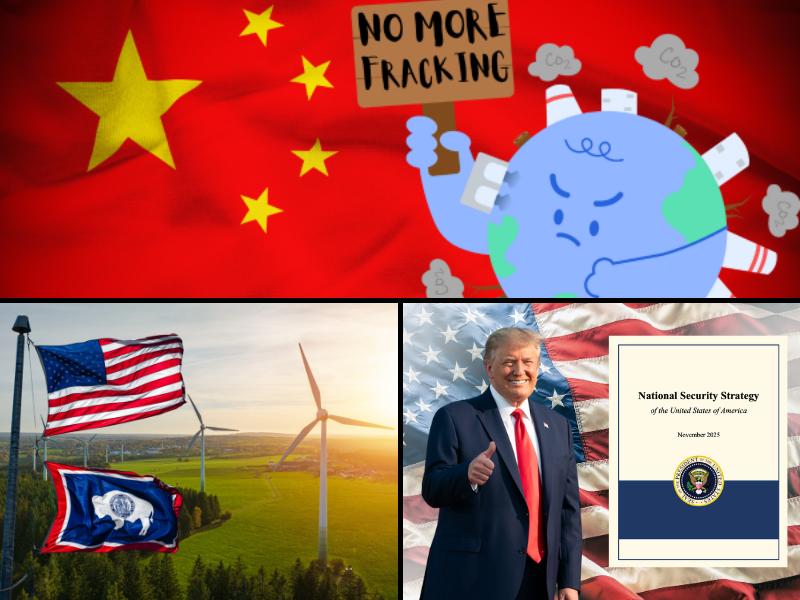Subscribe here.
Editor’s Note: Politicians, bureaucrats, and politically connected heads of industry around the world are beginning to push the idea of a “Great Reset” of the world’s economy and political systems. In truth, the plan is warmed-over socialism, with the same deadly, soul-crushing implications for any people forced to live under it. Because the Great Reset is being pushed in large part as a response to the so-called climate crisis, I thought CCW’s readers should hear more about it, and there are no better people to discuss it than those Heartland scholars, in this case Chris Talgo, who have been writing about it regularly at Stopping Socialism.
— H. Sterling Burnett
In early June, the World Economic Forum unveiled the Great Reset. As explored extensively on StoppingSocialism.com (a project of The Heartland Institute), the Great Reset is a farce having very little to do with saving or conserving the environment and everything to do with crony capitalism and forcibly imposing unreliable and unaffordable green energy schemes on the world. In short, the Great Reset is the Green New Deal on a worldwide scale.
Like the Green New Deal’s advocates did at its rollout, those pushing the Great Reset are using fearmongering and unwarranted doom-and-gloom predictions to make people believe it is the only way to avert a global apocalypse.
According to Klaus Schwab, founder and executive chairman of the World Economic Forum, “We only have one planet and we know that climate change could be the next global disaster with even more dramatic consequences for humankind. We have to decarbonize the economy in the short window still remaining and bring our thinking and behavior once more into harmony with nature.”
“We need a change of mindset, moving from short-term to long-term thinking, moving from shareholder capitalism to stakeholder responsibility. Environmental, social and good governance have to be a measured part of corporate and governmental accountability,” Schwab said.
This sounds eerily like Rep. Alexandria Ocasio-Cortez’s (D-NY) forecast the world will end in 12 years unless the Green New Deal becomes the law of the land.
Not to be outdone, the Prince of Wales described the pressing need for the Great Reset in these terms: “In order to secure our future and to prosper, we need to evolve our economic model and put people and planet at the heart of global value creation. If there is one critical lesson to learn from this crisis, it is that we need to put nature at the heart of how we operate. We simply can’t waste more time.”
It is telling that almost all of the world leaders advocating a massive economic and social transformation in response to climate change say we must implement these comprehensive changes immediately or the world will end. How do they know that? They do not.
Adding fuel to the fire, U.N. Secretary-General António Guterres said, “The Great Reset is a welcome recognition that this human tragedy must be a wake-up call. We must build more equal, inclusive and sustainable economies and societies that are more resilient in the face of pandemics, climate change, and the many other global changes we face.”
Conveniently, neither Guterres nor the others offer specific policies that would achieve their climate goals. They are relying on platitudes and feel-good-isms to garner support for their position.
Perhaps the most telling description of the sheer size and scope of the Great Reset comes from Ma Jun of the China Green Finance Committee. Jun says the changes outlined in the Great Reset must be “greener than any of the previous recoveries.”
Jun says the Great Reset’s “stimulus package is very big—bigger than historic numbers.” How big? According to Jun, about 20 percent of U.S. GDP or 8 percent of China’s GDP. That’s bigger than big.
Jun also outlined the following policies as essential under the Great Reset:
1. “Make sure the percentage of green projects is higher than any other time in history.”
2. “Ensure projects that can’t be labelled as green are made to follow strict environmental standards.”
3. “Consumption stimulus needs to be green. Governments could make a list of green consumer goods and these should be given preference on a list of consumer subsidies and coupons.”
4. “Employment generation programs must be green. Migrant workers have lost jobs. Instead of paying them unemployment benefits we should ask them to plant trees and pay them for that.”
5. “Governments [need] to consider green bonds as much as possible. This enhances market participation, encouraging the private sector to join too.”
6. “Any central banks considering using quantitative easing should use green bonds.”
It is ironic China would be pushing for these uber-green policies. China leads the world in carbon dioxide emissions and is one of the planet’s foremost burners of fossil fuels, including coal. “Do as I say, not as I do” seems to apply in spades here.
The Great Reset is not about saving the environment. Neither is the Green New Deal. In truth, both programs are Trojan Horses for massive wealth redistribution and social-justice schemes on a level heretofore unseen. To date, many prominent Democrats and far-Left organizations (especially pseudo-environmental institutions) have supported the Green New Deal and/or the Great Reset.
Next year, the WEF will host a summit to connect “key global governmental and business leaders in Davos with a global multistakeholder network in 400 cities around the world for a forward-oriented dialogue driven by the younger generation.”
The last thing the world needs is a bunch of out-of-touch elites vacationing in Davos, Switzerland plotting to reset the world economy based on junk science and social-justice clichés to please the Greta Thunberg demographic.
If these elites are truly concerned about worldwide climate change, they should renounce their jet-set lifestyles and live like the rest of us. Unfortunately, that seems as unlikely as Greta giving up her 15 minutes of fame and going back to school full-time.
- Guest essayist Chris Talgo ([email protected]) is an editor at The Heartland Institute.
SOURCES: Stopping Socialism; World Economic Forum; United States House of Representatives
IN THIS ISSUE …
CORAL REEFS ADAPTING TO WARMER TEMPERATURES … PLANKTON CAPTURE MORE CARBON THAN PREVIOUSLY ESTIMATED … SHORT, MID-TERM CLIMATE DOMINATED BY NATURAL VARIABILITY
CORAL REEFS ADAPTING TO WARMER TEMPERATURES
Research recently published in the journal Current Biology shows some corals are adapting to warmer temperatures not by “bleaching” (losing all pigmentation and expelling the symbiotic marine life that makes corals bastions of biodiversity) but instead by transitioning to bright neon colors which attract the sea life back to the corals and help the colonies to recover and keep the symbiotic habitats alive. The scientists at the University of Southampton who conducted the research found “Colorful bleaching is a recurring phenomenon in reef regions around the globe.”
Although they still refer to the coral colonies’ response to warming as bleaching, in fact what seems to be occurring in at least some corals, including those in areas of the Great Barrier Reef in March and April in response to an influx of warmer ocean water, is the corals emit “green fluorescent protein-like pigments” which act like sunscreen. The vibrant colors on these corals benefit the interdependent species that live in a symbiotic relationship with them and entice the return of species that abandoned the coral as seas warmed.
“Bleaching is not always a death sentence for corals, the coral animal can still be alive. If the stress event is mild enough, corals can re-establish the symbiosis with their algal partner,” Cecilia D’Angelo, lecturer on molecular coral biology at Southampton and a coauthor of the study, said in a statement concerning the work.
SOURCES: Current Biology; Global Warming Policy Foundation
PLANKTON CAPTURE MORE CARBON THAN PREVIOUSLY ESTIMATED
A study by an international team of researchers from the United States, Australia, and Canada, published in the Proceedings of the National Academy of Sciences (PNAS), finds tiny, often-microscopic ocean life, phytoplankton, plankton, and zooplankton which serve as the base for much of the food chain in the ocean, absorb twice as much carbon dioxide during their lifecycle as previously believed.
“When plankton die or are consumed, a set of processes known as the biological carbon pump carries sinking particles of carbon from the surface to the deep ocean in a process known as marine snowfall,” writes lead author Ken Buesseler of the Department of Marine Chemistry & Geochemistry at Woods Hole Oceanographic Institution, in a summary of the article available at Watts Up With That. “Some of this carbon is consumed by sea life, and a portion is chemically broken down. Much of it is carried to deep waters, where it can remain for hundreds to thousands of years. If the deep oceans didn’t store so much carbon, the Earth would be even warmer than it is today.”
Previous research largely limited the measurement of “marine snowfall” to a reference depth of approximately 450 feet. The PNAS study, by contrast, examined how plankton operates in and cycles through the entire euphotic zone, the layer of ocean that receives sufficient light for photosynthesis to occur. The authors discovered the euphotic zone varies in depth around the world’s oceans—as shallow as 100 feet below the surface in some areas and extending 550 feet below the surface in other places—and they calculated the biological pump carries twice as much heat-trapping carbon dioxide away from the sea surface to the ocean depths as previously assumed. Some of the marine snowfall in the depths is consumed by deep-water fish, squid, worms, and jellyfish, with much of the remaining dead and dying plankton sinking to the cold ocean depths where the carbon dioxide is trapped for centuries if not millennia.
If correct, the importance of these findings should be clear for the climate change debate because oceans play a critical role in the carbon cycle and the amount of atmospheric carbon dioxide. If ocean life absorbs and oceans ultimately store more carbon dioxide than climate modelers assume, such models predicting dangerous warming are not trustworthy. As such, they should not be used to made climate predictions.
SOURCES: Proceedings of the National Academy of Sciences; Watts Up With That
SHORT, MID-TERM CLIMATE DOMINATED BY NATURAL VARIABILITY
Research from an international team of scientists working in Germany, Switzerland, and the United States shows internal variability driven by natural factors dominates temperature and climate trends over the short and medium terms. This finding explains the recent warming hiatus, which climate models that assume greenhouse gas concentrations drive climate change are unable to account for.
Using six different sets of initial conditions run through the Coupled Model Intercomparison Project 5 general circulation model, the scientists found on times scales of 15 to 30 years, surface temperature trend projections are dominated by internal variability, such as changes in cloud cover and ocean circulation patterns, with increases or decreases in greenhouse gas emissions having little or no influence on resulting climate patterns.
“Perhaps counter intuitively, in all models a lack of warming, or even a cooling trend could be observed at all individual points on the globe, even under the largest greenhouse gas emissions. … [E]ven out to thirty years large parts of the globe (or most of the globe…) could still experience no-warming due to internal variability,” write the authors.
This finding confirms what many climate realists have long argued. For each of the 15 to 30 year periods since the end of the Little Ice Age—the initial warming period through the 1930s, the relatively pronounced cooling which led some scientists to predict the return of an ice age from the 1950s through the 1970s, the modest warming of the 1980s, the temperature hiatus beginning in 1998 or 1999, and the return to modest warming since approximately 2016—are dominated by natural factors, with contributions, perhaps, from human landscape alterations.
The rise in carbon dioxide emissions, accounting for only a modest amount of the total greenhouse gases in the atmosphere, has at most a barely discernable impact on climate.
SOURCE: Environmental Research Letters



